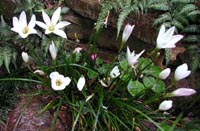Resource Library
Plant of the Week: Rain Lily
The University of Arkansas System Division of Agriculture does not promote, support or recommend plants featured in "Plant of the Week." Please consult your local Extension office for plants suitable for your region.
Plant of the Week
Rain Lily
Latin: Zephyranthes candida

Recently, I saw my first rain lily blooms of the season; two days later I learned that the man who sent me the seeds for these plants had passed away. Carl Amason (1924 - 2005), known throughout the state for his gentle ways and interest in gardening and gardeners, was no more.
The seeds arrived out of the blue from Carl about a dozen years ago. I met him a few years earlier, and we struck up a conversation about plants and gardens. It didn't take long to realize that he was not a casual garden enthusiast. From that first meeting, I was impressed with his range of plant knowledge and the scientific authorities he quoted. He became my role model of a quintessential southern gentleman - a kind of Colonel Sanders of the plant world.
The rain lilies (Zephyranthes candida) were just one of the thousands of plants he grew in his 50-acre garden near Calion (Union County), just north of El Dorado. This rain lily, a member of the amaryllis family and native to South America, produces foot long, slick, green, rush-like leaves from thumb-size bulbs.
During the heat of late summer, especially after a summertime cloudburst, solitary white, funnel-shaped blooms appear. The blooms remain open for three days or so, but new ones will appear over the next month, seemingly at the whim of the plant.
It has been a tough year for Arkansas gardeners named Carl. Last summer, we lost Carl Totemeier, who was heading up the botanical garden project in Fayetteville; in the spring Carl Hunter, the wildflower authority passed and now Carl Amason. Like plane crashes, they seem to come in threes.
Carl Amason's garden was a rustic affair. It had sections developed in a formal style while other areas were intended to be natural. As he got older, especially after complications from a tick bite, the garden became more than he could manage on his own.
In his last letter to me, he said; "Lately I have become a dedicated gardener and would enjoy it more if I didn't have problems with deer, drought, ticks, and today, cold weather." On my last visit, we walked around the garden and were constantly pulling back piles of brush so he could show me some hidden treasure. These brush piles were his attempt to keep the deer from eating his garden treasures.
Carl, a WW II veteran who fought in Italy, was a renaissance man interested in all aspects of the natural world, in geography and in history, especially Civil War history. He never strayed far from his roots in Union County, spending most of his career as a chemist for American Oil in El Dorado.
In 1980, he became one of the founding members of the Arkansas Native Plant Society. To honor him, the society gives the Carl Amason Conservation Award to individuals who help preserve Arkansas' natural heritage. Mary Ann King from London, Ark., a past president of the society and long-time friend of Carl, told of the pleasure of going on field trips with him and his generosity in sharing knowledge, plants and seeds with everyone.
Each summer, when my rain lilies bloom, I will think of Carl Amason. Thus far, I have given them little attention other than a semi-sunny site along one of the pathways in my garden. They seem to do fine in my heavy clay, but maybe they would do even better if I could find a piece of sandy ground and lavish upon them the affection they once received in garden near Calion from whence they came.
By: Gerald Klingaman, retired
Extension Horticulturist - Ornamentals
Extension News - August 19, 2005
The University of Arkansas System Division of Agriculture does not maintain lists of retail outlets where these plants can be purchased. Please check your local nursery or other retail outlets to ask about the availability of these plants for your growing area.